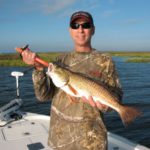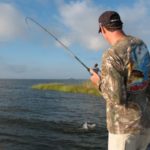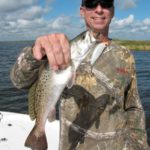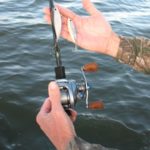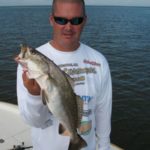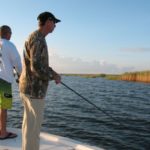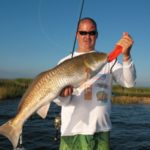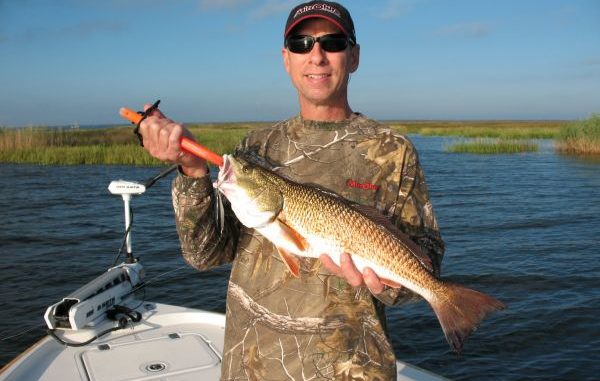
After sweating to catch a few summer trout, take things easy this month as cooler weather turns on packs of trout and redfish that invade the marshes of Delacroix.
Ah, sweet November. Brisk air, falling leaves, cooler temperatures and the official end to hurricane season.
That’s something to celebrate in itself.
And, of course, Thanksgiving. Let’s not forget the national mandate to eat a turkey at least that one day of the year.
And fishing, which gets rejuvenated every year in November. After our long, trout-less summer, we’re in dire need of some rejuvenation.
The summer of 2014 could go down as the summer of no trout, but the fall isn’t destined to repeat the summer. I’d heard reports from anglers who said lots of shrimp were showing up in the transition area waters, and we know from experience when that happens the trout are not far away.
The reports coincided with an invitation to a late-September outdoor writer’s media event at Silverside Lodge in Hopedale. The idea was to get us together for some socializing and introductions, and then take us all fishing.
Since any plan that involves me going fishing is a good plan, I jumped at the opportunity.
When the early morning fishing assignments were made and writers and reps were to be divided among three boats, long-time MirrOlure representative Drew Davis and I were handed over to Capt. Joe Vinson, an 8-year veteran fishing guide.
My first questions to Vinson were the usual ones I ask on any fishing trip.
“What’s your plan for today? Where will we be fishing?”
“I’d like to see if we can find some trout,” Vinson answered. “I know we can catch some reds, but since we have the MirrOlure rep aboard, let’s tie on some of his topwater baits and shallow-swimming baits, and go hunt some speckled trout in the transition areas.”
We liked the plan and Vinson pointed the bow of his 24-foot Triton bay boat down the Dudenhefer Canal, and headed south.
After a short, circuitous route, he turned into the Twin Pipelines, and from there continued south toward some nameless fringe islands.
“I’ll fish a lot in November and December on what’s considered the Delacroix side, even into the Pointe a la Hache area if that’s where the fish are,” Vinson said. “And we’re seeing a lot of shrimp jumping out here whenever you pass through the lakes and bays, and a lot of baitfish, too.
“Bait has really moved into the transition areas, and that means the trout should be in there, too.”
The winds were blowing from the east at a pretty good clip, which made for a chop on the surface as we slowed to approach a small, good-looking marsh island. With the wind to our backs Vinson dropped the trolling motor and positioned us so we could cast toward the points and edges of grass, and hope for some speckled trout blow-ups on our topwater baits.
Davis had quite an array of MirrOlure baits aboard for us to try, and I chose a chartreuse one from the new C-eye category. Davis and Vinson had on Top Dog Jrs. in the new redfish color.
We all worked our baits along the shoreline as we slow-trolled within casting distance of the bank.
Water color or clarity wasn’t bad despite the relentless winds we’d had for the past week, but I wouldn’t describe it as pretty, either. A bit stained or cloudy might be a better description.
At first, it seemed like this would be a fruitless stretch of island, but then we began seeing signs of bait in the water.
Some large shrimp were startled by our boat or by some nearby predator and jumped up on the surface. Baitfish scattered here and there, as something was obviously in pursuit.
Good signs! Then Davis had a couple of short strikes on his topwater. How a toothy critter can pop at all those treble hooks and not get snagged is an unsolved mystery, but after it happened a few more times to both Davis and Vinson, the former switched over to a black-and-silver MirrOdine XL twitchbait — a subsurface bait.
“If they won’t commit to the topwater, maybe this shallow-swimming bait will entice them,” he said.
It did.
Davis caught a nice trout, and then Vinson caught one right behind him.
I decided to stay with the topwater bait a little longer, and was soon rewarded with a big hit from a hungry redfish. This was a big fish in the 20-pound class, and I was fishing with 12-pound monofilament. So I had to take my time and play him until he wore himself out.
With braid, you can horse them around a bit without much risk of losing the fish, but mono affords no such option. You either wear them down or they break off.
I had lost an identical lure the day before to a big redfish while fishing on another captain’s boat, so I didn’t want a repeat. After a short battle, the big fish exhausted itself and surrendered to the landing net.
We took a few photos and released it to fight another day.
Each time one of us stuck a fish, Vinson would lower the Power-Pole and we’d all fish to see if we could stick another.
Mostly the fish were still scattered, but a couple times we did have two on at once, with both trout and reds falling for our lures.
“The fish were just starting to huddle up in small bunches when we had another heat spell, and that scattered them again,” Vinson said. “But with each passing front, no matter how mild it is, it’s another step in the gradual cooling process of fall.
“By November we should be going full blast.”
Vinson said he loves fishing the fall.
“It’s just so much more pleasant and enjoyable to be outdoors,” he said. “You don’t have the sweltering heat and humidity of summer, and I don’t feel the stress of summertime fishing.
“In the summer you have to always be in a hurry — get started super early to get on the very early and very short trout bite, race to get bait, race to be at the premier spots that can get choked with boats very early.
“It’s a lot of hurry-up and stress.”
That’s not the case when temperatures cool down.
“In November you can slow down, unwind, take your time and enjoy the whole process,” Vinson said. “Fish are all over, so there’s no one spot you have to rush to get to first. Fish are closer in, so you don’t have to blast off and make the long hauls to Breton Sound or Black Bay.
“Fish are much more cooperative, willing to eat live and artificial baits, and it’s a great time to toss topwater baits and shallow twitchbaits. It’s much more mellow fishing this time of year.”
We continued to fish around the marsh islands, picking up a trout here and there, and having our baits inhaled by ravenous redfish.
The trout mostly hit the Paul Brown’s Soft-Dines, but I did pick some up on that chartreuse topwater bait.
On the other hand, the reds weren’t the least bit finicky, hitting just about anything we threw. Davis caught reds on the MirrOlure Little John, a straight-tailed soft-plastic lure he was tightlining. But they also ate up our topwaters and twitchbaits, and I caught a couple on a VuDu shrimp under a cork.
We chose not to use live shrimp on this trip, but I suspect if we did we might have doubled our catch.
When one island played out, we moved to another. A couple of spots we stopped at were too windblown and the water just too muddy looking to try, so we’d move along until we found a more promising spot, and we seldom failed to get a strike.
“If I was going to summarize my advice for November fishing, I’d say three things: Look for birds, fish points with current and fish a falling tide,” Vinson said. “That simple.”
Capt. Joe Vinson guides for Silverside Lodge and can be booked at 504-278-FISH.
